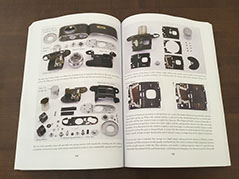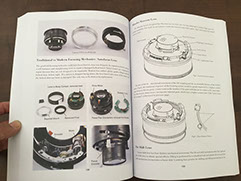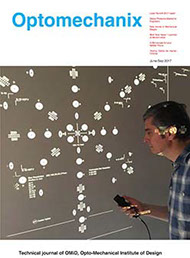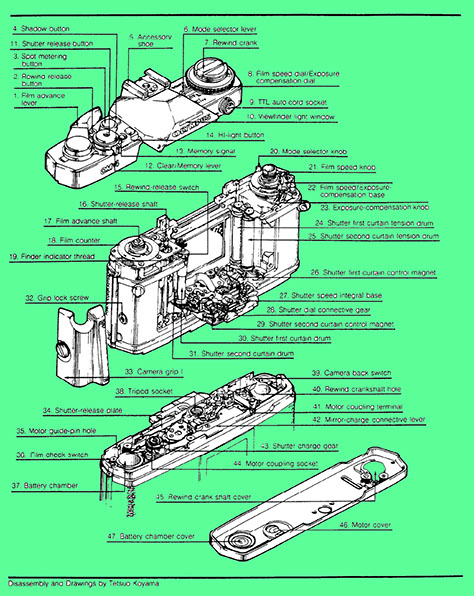
Leica Design 101
ISBN 978-1-5136-3085-4
The most illustrated technically rich book written on Leica from Ur Leica to M3.
167 pages, in full color
Available at Amazon.com


Restoring The SLR
ISBN 978-1-5136-4044-0
One of the most comprehensive books written on camera design history.
300 Pages, in full color
Available at Amazon.com



Optomechanix Quarterly Magazine
Quarterly publication of OMiD museum, download in PDF format from www.optomechanix.org
40 pages, in full color



Book Announcement: 4 New Books on Camera Design History
What was so special about the film era we left behind?
We will have 3 books covering the history of cameras, and a more complete book on Leica would cover Leicaflex, and the rest of M series Leicas, but why? By undervaluing cameras, and relying on the mobile phone, we have moved towards quick solutions, and have lost our simplest human experience along the way. We have become an impatient generation. Even with the digital camera, it took an hour to prepare it for a birthday party, but the mobile phone is always with us ready to shoot. Where is all our spare time being spent on, or do we have any spare time? The stories of cameras, its designers, and visionaries belong to a not so distant generation who pledged to our simplest values like being more patient in our daily life, enjoying more quality time with friends, and having stronger family values. One example is Walter Mandler, the man behind most of the M-seies Leica lenses, whose remarkable attitude throughout his career could be a great inspiration for our young engineers. He always passed the design credit to the talents of his peers, and saw his inventions as an outcome of their collaborative effort. Maitani's story at Olympus, the man behind most of Olympus cameras is another inspiring story. Today’s value engineering has turned engineers to more of a show off character: "If you want to get a raise, you must be more visible". We identify ourselves as “look what I have” instead of “see how much I understand”.
How the mechanical watch industry survived the Quartz watch
This is a generation of indifference. The watchmaking industry was able to survive after Quartz watches hit the market in the 70’s because that generation carried strong values to save the mechanical watch. I assure you if it had happened today, they would have been far less successful in implementing it. When David Chan, standing in the middle of his camera shop in Hong Kong (see the links) is asked about the price of his cameras, he says: "Not for sale", it has a much deeper meaning. When he says: "Contarex was the best camera ever made", it's something which is missing in today's products. If you don't keep buying a new mobile phone, you'll fall behind because it won't run with the latest version of Instagram. We all have one or two HP printers sitting in our garage because they only came with drivers for Windows XP. We post happy selfies on facebook that don’t say much about how we truly feel. Today’s generation suffers from loneliness, and lacks determination. Our kids have no patience to play with the Erector Set. They learned to spend less than an hour with every toy that came with their kids meals. We got all this by rushing into the impatient digital age.
We can't go back to film
Speaking of the digital age, if you study Russian spacecrafts in early years of planetary exploration, and how they had to first capture images on film inside a briefcase size camera with chemicals, then scan them on a drum to send them to earth, you would surely appreciate the emergence of digital cameras. The Perseverance rover that recently landed on Mars has 23 of them, with two microphones. We can’t go back to the film era, so why explain how cameras worked? For starters, the development of SLR would make a great engineering book for today’s opto-mechanical engineers. The first SLR camera prototypes were made during world war II in Europe: Exakta, Contax, Rectaflex, Praktica, and the rest of the Japanese camera brands started at that time. The self capping design of Leica 1 introduced in 1924, made camera design sequential, and it took 80 years for the SLR to reach its current form. Back then, sequential meant all mechanical, and it’s now electronically controlled.
Educational value of illustrative books
Another good reason for putting out these books is that mechanical watch enthusiasts have been far more educated about watches than general public's knowledge of cameras. There are hundreds of watchmaking books available with detailed drawings on how they are made, and how they work. You can’t find more than one or two such books on cameras. Modern's inside your camera series did this for at least a decade (see below), but can you find one book having such illustrations? The attitude towards cameras is so different in Japan because their camera industry has been putting out these highly illustrated technical articles about cameras like comic books. I built my first SLR during my high school years in America, but it was the "Photo Industries" magazine in Japan that wrote a 5-page article on it. If you do a search on eBay for any camera, most of them come from Japan because they were collecting them a decade ago while everyone else were getting rid of them.
100 cameras explained
The upcoming books will be historical, preserving the stories of camera designers inside the Photo industry. Internal designs of cameras will be explained with full color illustrations covering every major brand from Exakta camera of 1940's. If you are a collector, these books will have engineering information about cameras that would at least show you how to take the top cover off, and perhaps do minor repairs. They will be a reference book covering the innovations, and triumphs of major players in camera design industry in past 85 years. The book will cover the internal design of 100 cameras:
Sport 5, Focaflex, Exa 1A, Zenith C, Canon AE-1, Bronics S, Bronica EC, Olympus Pen-F, Wrayflex, Ucaflex, Periflex, Graflex, Alpa 9f, Canon Pelix, Canon FTb, Contax-S, Praktica, Rectaflex, Canon T90, Yashica Su40E, Alpa Panoramic, Contax-1, Contax-II, Hasselblad 500C/M, Hasselblad 1600F, Kodak Retina, Canon T50, Canon 14fps, Nikon FM2, Nikonos II, Beulieu 4000 Zm4, Minox A, Mercury, Bolex K2, Kiev 10, Robot II, K20 Aerial, Hasselblad Moon, Linhof T617, Pentax 645, Minolta Vectis, Duflex, Nikkorex, Arriflex ST, Arriflex SR2 II HS, Bolex H16, Konica FS-1, Rollei 35, Nikkormat EL, Olympus OM-1, Konic Autorefelx T3, Canon F-1, Nikon F2-s, Pentax Es II, Topcon Super DM, Canon EF, Alpa 11EL, Fujica ST 901, Polaroid SX-70, Seiko MF Shutter, Pentax K2, Hasselblad 550C/M, Minolta XE-7, Mamyia RB-67, Contax RTS, Bronica ETR, Olympus OM-2, Mamyia 645 1000S, Nikon FM, Pentax ME, Minolta XD-11, Canon A-1, Pentax Auto-110, Nikon EM, Nikon F3AF, Minolta X-700, Nikon FA, Minolta Maxxam 7000, Fujica AZ-1, Photo Argus: Minolta SRT101, NikonF, Topcon Super D, Pentax Spotmatic, Rollei SL66, Yeshiva TL ElectroX, Konica Autoreflex T, Exakta VX1000.


Good old Modern Photography's "Inside Your Camera Series" lavishly illustrated by Tetsuo Koyama, and written by Jason Schneider, explained camera design to the general public. This particular article was written by Youshihisa Maitani, and his colleague at Olympus about the OM-4. Olympus has recently come to an end, and soon will be Pentax. Minolta, and Konica disappeared from the scene almost a decade ago.
